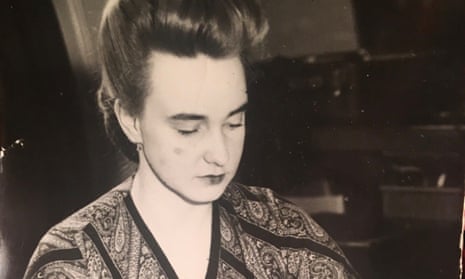Thirty-nine years after her death, the artist Maeve Gilmore is finally having her first institutional solo show. A display of 20 paintings, selected in consultation with her family and on show at Studio Voltaire in London, reveal her to be a shrewd and loving observer of domestic life, who took particular delight in the playfulness of her children as they lost themselves in gymnastic stunts or in games of dressing-up and cat’s cradle.
Gilmore was a painter, writer and illustrator whose early promise in the 1930s was disrupted first by war and then by marriage to Mervyn Peake, author of the Gormenghast trilogy of novels, whose career she put selflessly before her own. She did not shrink from depicting the darker side of the maternal lot, most strikingly in a picture of a small boy clawing for attention at his mother’s skirts while she, bare breasted, holds a flower out of his reach. The shadow of the flower falls on the wall behind her like the silhouette of an axe.
But hers is not a story of Cyril Connolly’s “pram in the hall” – of creativity sacrificed to the demands of parenthood. Nor is it a tale of suffocation by the ego of a monstrous artist husband, as told in Charlotte Mendelson’s novel The Exhibitionist. It is more nuanced than that. Gilmore may not have had, or pursued, a public platform, but her artistic drive remained – not least in the murals on the walls of her London home, which have sadly now been lost to the decorative taste of subsequent owners.
The works in the show are owned by members of her family under the management of her estate. They are not for sale. Gilmore belongs in the company of women who deserve respect for their artistry, not pity for their disadvantages. Women like her own daughter-in-law, Phyllida Barlow, who married one of the small sons regularly featured in Gilmore’s paintings, the artist Fabian Peake. For decades Barlow combined teaching and motherhood with building up a well-regarded body of work, even though she only found wide acclaim in her 60s.
There are many more such success stories on the walls of the Tate Modern, as part of the current Surrealism Beyond Borders exhibition. Two of them, Leonora Carrington and Remedios Varo, were friends who set up a small, female surrealist cell in Mexico City, where they playfully merged art and life, serving their unsuspecting friends omelettes made with human hair, and “caviar” of ink-dyed tapioca, as Joanna Moorhead recorded in a recent biography of Carrington. The Berlin-born artist Méret Oppenheim (a glaring omission from the Tate show) parlayed a convivial Parisian lunch with Pablo Picasso and Dora Maar into a fur-covered cup and saucer.
The American surrealist Dorothea Tanning once declared that there was no such thing as women artists. “It’s just as much a contradiction in terms as ‘man artist’ or ‘elephant artist’,” she said. “You may be a woman and you may be an artist, but the one is a given and the other is you.” Four decades after her death, Maeve Gilmore is an artist.
